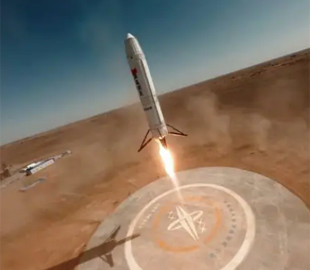
China's private rocket company Deep Blue Aerospace said its first kerosene-powered Nebula-1 reusable rocket failed a high-altitude ascent test.
p>
Despite completing 10 out of 11 tasks during the vertical takeoff and vertical landing tests, the rocket encountered problems in the final stage, which caused the accident. According to the company, Nebula-1's three engines initially performed as expected, and the rocket was able to climb to a significant altitude, after which the descent process began.
The two engines then shut down as planned, but unforeseen complications arose during the attempt to land at the designated site. The mechanism suddenly failed, causing the Nebula-1 rocket to make a hard landing. Footage from the tests showed that the upper part of the rocket broke off and a fire started.
Nebula-1 – a two-stage rocket with a diameter of 3.35 m, running on a mixture of kerosene and liquid oxygen. Her first stage has nine 3D-printed Thunder-R1 variable thrust engines. The second stage is driven by one engine. This configuration in the future will allow the rocket to transport up to 2000 kg to a low Earth orbit.
200% Deposit Bonus up to €3,000 180% First Deposit Bonus up to $20,000Experts suggest that the use of alternative fuels such as kerosene, methane or liquid oxygen can significantly reduce costs and make launches more environmentally friendly and efficient. Over the past year, several private Chinese space companies have been testing various spacecraft to show they can handle the growing demand in the country's commercial space sector. This is happening against the background of increased competition for the creation of satellite groups that could become competitors of the Starlink network.
The company Deep Blue Aerospace received significant financial support this year, which was aimed at the development of the program of reusable rockets. The manufacturer has announced that it has received tens of millions of dollars in recent funding rounds, furthering its efforts to develop reusable rocket technology.
Drone footage from Deep Blue Aerospace's VTVL attempt today. Great view of the landing and explosion. https://t.co/jlZhrYRLMI pic.twitter.com/rne1aT5566
— Andrew Jones (@AJ_FI) September 22, 2024
The first launch of the Nebula-1 rocket was intended to test the ability of the first stage to make a controlled landing using retroactive thrust and landing legs. Two years ago, the company successfully conducted launch and landing tests after ascending to an altitude of a kilometer, but the most recent test of the first stage of Nebula-1 ended in a crash.
The team is studying the data to determine the cause of the explosion and prevent this problem in future rockets . Moreover, together with Nebula-1, Deep Blue Aerospace is also developing a more powerful version of Nebula-2, which will be able to transport 20,000 kg of cargo to low Earth orbit.

